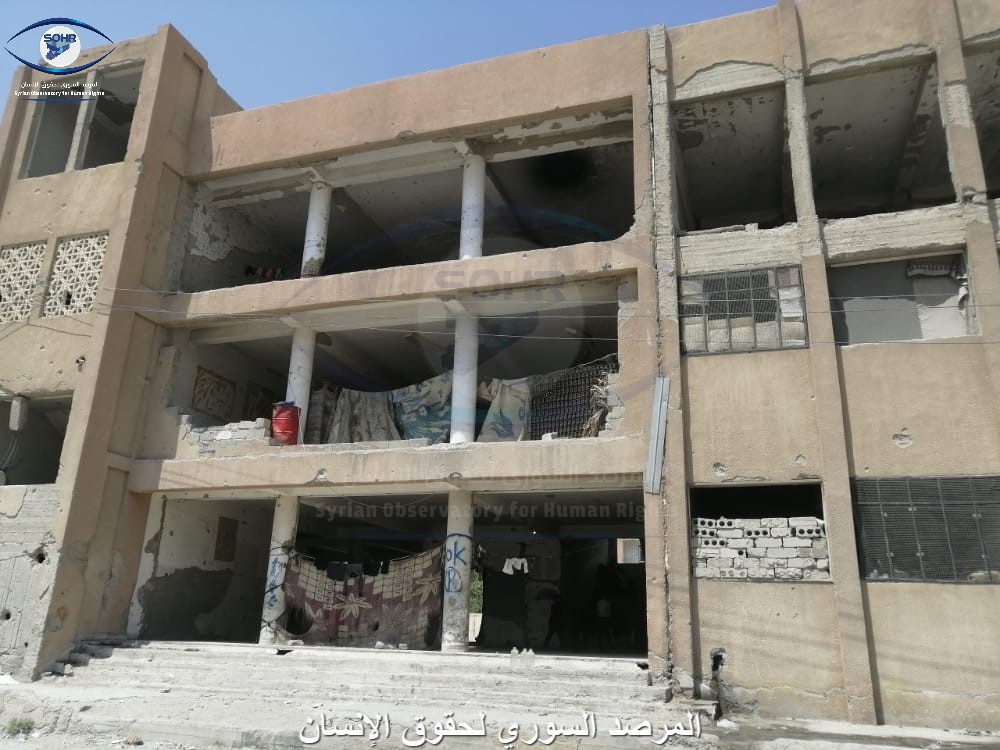Looming tragedy | Safety and lives of thousands of civilians in 58 camps and resettlement centres in Al-Raqqah at risk as winter approaches
With the onset of cold weather, thousands of displaced families in Al-Raqqah are suffering greatly in light of the dreadful living conditions and suspension of support by humanitarian organisations.
Al-Raqqah province hosts 58 makeshift camps and unqualified resettlement centres, mainly devastated schools and governmental institutions which lack doors, windows and services, as well as uninhabitable destroyed civilian houses whose owners gave up them for the favour of the new comers.
Speaking to SOHR, a 40-year-old displaced woman from Al-Qusayr area in Homs countryside known as “Um Hala,” who lives with her husband and their five children in “Khadijah” school, says “I live with my family in a classroom in this devastated school for one year and a half. We were forced to displace from our area in 2012 when we settled in Ikdah camp on the Syria-Turkey border. Because of the harsh living conditions and disability of my husband, we preferred to leave with other families from Homs countryside to Al-Raqqah. However, the high rental fees and high cost of living led us to seek shelter in this school, as it has not been suitable for living for anybody and no one would force us to leave it. My oldest son aged ten years, my eight-year-old son and my seven-year-old daughter work in collecting and selling scrap and used plastic and copper. They roam streets, searching for these objects, despite the risks they may be subjected to. My children are the breadwinners of the family, as my husband suffers from a mobility handicap in his pelvis and he is unable to work. Many organisations and media agencies visited us and took pictures and videos of me and my children. They promised us to improve our living conditions, but we have got nothing.”
In makeshift camps in Al-Raqqah, such as “Al-Sawafi” and “Al-Maqas” camps, displaced people from Hama and Homs countryside and Palmyra city have complained of the unavailability of clean drinking water, where inhabitants of these camps are forced to get the water they need directly from the river, despite the risk of using contaminated water, especially with the outbreak of diseases, particularly cholera.
In this context, the bureau of camps and displaced people affairs in Al-Raqqah has counted the number camps and families that have been displaced to Al-Raqqah in an attempt to merge those camps and decrease their numbers, so that these camps can get satisfying support under programs by humanitarian and relief organisations. According to the bureau’s statistics, there area 58 camps in Al-Raqqah city and countryside.
On the other hand, a 67-year-old woman known as “Hajja Fadila” from Al-Busayrah city in the eastern countryside of Deir Ezzor says, “in Sahlat Al-Banat camp, we suffer from the suspension of support, especially the issue of the lack of drinking water. We are obligated to wait for water trucks which come only once a day. These trucks sell us water it had taken directly from Sifon irrigation canal nearby the camp. Children, on many occasions, had fever and diarrhea because of the contaminated water. Most of the tents, which have not been changed for two years, are very torn and do not protect us from the cold or hot weather. Winter approaches, and we can do nothing for the children. For heating, we have to collect dung of cows and sheep, dry and store it to be used in winter.”
















